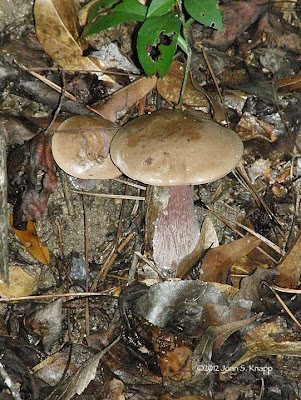July 21st, 2012. We set out to look
for more routes with gravel roads - preferably not mowed - that would be good
places to look for wildflowers. We found ourselves in Greene County, Georgia –
not far east of the Scull Shoals Experimental Forest. In fact, if we continued
on the forest road we use to get to the Scull Shoals EF, we would reach this
area. We just don’t go this way often – that may have to change.
It’s probably also important to note that, after
months without any rain and temperatures in the 90s F, we’d had about five very
welcome inches of rain. I hadn’t thought much about it, but these are ideal
conditions for mushrooms to appear.
After leaving the Amanita jacksonii, we
continued on gravel roads and turned on a road that traveled through a heavily
shaded area beside a small creek that was flowing fast after the recent rains.
We found quite a variety of mushrooms – seven in all - more than we’re used to
seeing in a short section of road. They were growing on an embankment separated
from the road by a slippery ditch so I couldn’t get close to them to determine if they had gills or were polypores.
Another polypore
Cantharellus cinnabarinus The caps were about 1 inch in diameter I did straddle the ditch briefly to get closer to these.
This mushroom looks very like one that grows at
Fort Yargo State Park. They frequently hang just below the lip of the bank
above the lake with only the cap showing.
Another Boletus sp., Boletus campestris?
*****
An Amanita sp.
It’s interesting how the partial veil was disintegrating
Yet another
mushroom that only showed its cap
The road
emerged from this shaded area into planted pine forests where we found…
A young
bolete.
The
remainder need some perspective…
*****
The cap on
this mushroom was 6-7 inches in diameter
*****
Another
Boletus sp.? The perspective shot for this mushroom seemed somewhat humorous. There
are two more mushrooms above and to the right behind some pine needles. It’s as
if they’ve sent this mushroom out and are waiting to see what happens before
they come out.
*****
This was a
captivating sight. This mushroom looked a little alonely among the young pine tress. It was
6-7 inches tall and looks like an Amanita sp.
I wish I
knew more about American mushrooms. It’d be fun to be able to identify them all.
Click on
the image to view a larger image
Related
post:
- American Caesar’s Mushroom (Amanita jacksonii) Revsited















































